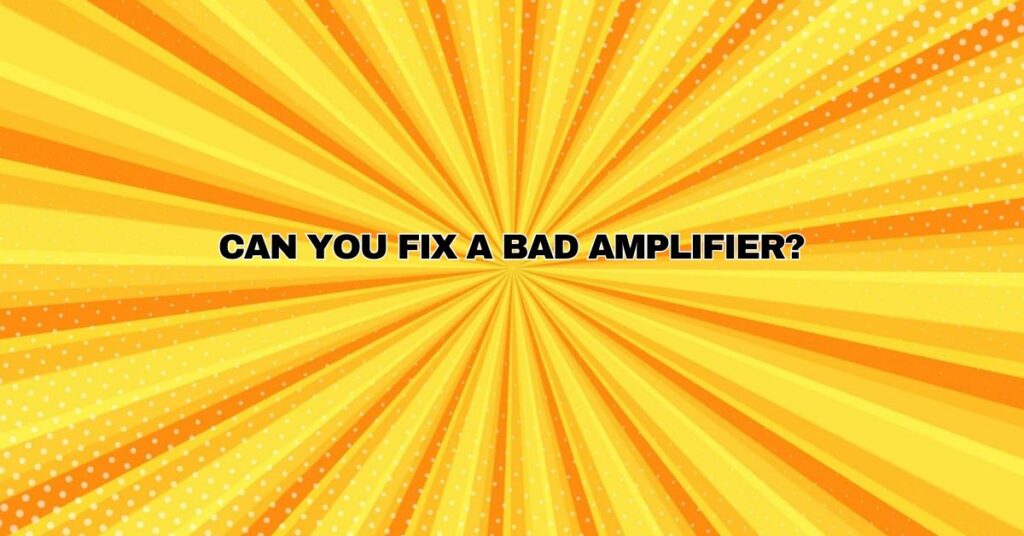Amplifiers play a vital role in the world of audio, serving as the powerhouse that drives sound through speakers and headphones. However, amplifiers, like all electronic devices, can develop issues over time, leading to degraded audio quality or even complete failure. The question that often arises is whether it is possible to fix a bad amplifier. In this article, we will explore the common problems that amplifiers may encounter, the potential solutions for repairing them, and the considerations when deciding whether to repair or replace a malfunctioning amplifier.
Common Amplifier Problems
Amplifiers can experience a range of issues, some of which are more straightforward to diagnose and repair than others:
- No Sound or Low Output: This problem can result from a blown fuse, faulty wiring, loose connections, or a malfunctioning power supply.
- Distorted Sound: Distortion can stem from damaged transistors, capacitors, or other internal components. It can also be caused by overloading the amplifier.
- Hum and Noise: Hum, buzz, or background noise can be due to grounding issues, poor-quality cables, or damaged internal components.
- Channel Imbalance: In stereo amplifiers, one channel may produce louder or quieter sound than the other due to issues with volume controls, potentiometers, or amplifier circuitry.
- Intermittent Operation: An amplifier that works sporadically may have loose internal connections, cold solder joints, or failing components.
- Overheating: Overheating can lead to thermal shutdown or long-term damage. Causes may include inadequate ventilation, dust accumulation, or malfunctioning cooling fans.
Potential Solutions for Amplifier Repair
Depending on the nature and severity of the amplifier problem, several potential solutions exist for repairing it:
- Fuse Replacement: If the amplifier has no power or produces no sound, checking and replacing the fuse (if blown) can often resolve the issue.
- Cleaning and Maintenance: Cleaning the amplifier’s internals to remove dust and debris, as well as checking and tightening loose connections, can alleviate issues like overheating and intermittent operation.
- Component Replacement: For issues like distortion or channel imbalance, replacing damaged transistors, capacitors, or other internal components may be necessary.
- Grounding and Cable Checks: Addressing grounding issues and replacing poor-quality cables can eliminate hum and noise problems.
- Volume Control and Potentiometer Repair: If the amplifier experiences volume control problems, repairing or replacing the potentiometers can restore balance.
- Professional Servicing: Complex or severe issues, such as major component failures or circuitry problems, may require the expertise of a professional technician or electronics repair service.
When to Consider Repair or Replacement
Determining whether to repair or replace a bad amplifier depends on various factors:
- Cost of Repair: Consider the cost of repairs compared to the amplifier’s current market value. If the cost of repairs approaches or exceeds the price of a new, comparable amplifier, replacement may be the more practical option.
- Age and Obsolescence: Older amplifiers may be more challenging to repair due to the availability of replacement parts. Additionally, newer amplifiers may offer improved features and performance.
- Warranty: If the amplifier is still under warranty, it may be more cost-effective to have it repaired or replaced through the manufacturer’s warranty service.
- Sentimental Value: In some cases, an amplifier may hold sentimental value or have unique characteristics that make it worth repairing despite the cost.
- Professionally Evaluated: If you are uncertain about the extent of the damage or the feasibility of repair, it is advisable to consult a professional technician for an evaluation.
Conclusion
In many cases, a bad amplifier can be repaired, restoring it to its former glory and extending its lifespan. Simple issues like blown fuses or loose connections are often straightforward to address. However, for more complex problems or amplifiers that are no longer cost-effective to repair, replacement may be the better option. Ultimately, the decision to repair or replace an amplifier should consider factors such as cost, age, warranty, and the amplifier’s sentimental or functional value to you. Whether through DIY troubleshooting or professional servicing, the goal is to revive the sound and enjoy the music or audio once again.


